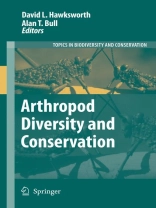Despite their enormous bulk and complexity of architecture, plants make up only around a quarter of a million of the 8 million or so species on Earth. The major components of biodiversity, instead, are the smaller, largely unseen, silent majority of invertebrates – most of which are arthropods. Vertebrates, a mere blip on the biotic horizon, are elevated in importance in the bigger scheme of things only by the human psyche.
This collection of more than 30 peer-reviewed papers focuses on the diversity and conservation of arthropods, whose species inhabit virtually every recess and plane – and feature somewhere in virtually every food web – on the planet. Highlighting issues ranging from large-scale disturbance to local management, and from spatial heterogeneity to temporal patterns, these papers reflect some of the most exciting new research taking place today – and in some of the most biodiverse corners of the planet.
Tabella dei contenuti
Arthropod diversity in Lama forest reserve (South Benin), a mosaic of natural, degraded and plantation forests.- Ecosystem disturbances and diversity increase: implications for invertebrate conservation.- Effects of landscape elements on the distribution of the rare bumblebee species Bombus muscorum in an agricultural landscape.- How ant nests increase soil biota richness and abundance: a field experiment.- Host specificity, alpha- and beta-diversity of phytophagous beetles in two tropical forests in Panama.- Vertical and temporal patterns of biodiversity of fruit-feeding butterflies in a tropical forest in Uganda.- Associations between weevils (Coleoptera: Curculionidea) and plants, and conservation values in two tussock grasslands, Otago, New Zealand.- Effects of management intensity and season on arboreal ant diversity and abundance in coffee agroecosystems.- Influence of habitat fragmentation on the genetic variability in leaf litter ant populations in tropical rainforests of Sabah, Borneo.- Comparing relative model fit of several species-accumulation functions to local Papilionoidea and Hesperioidea butterfly inventories of Mediterranean habitats.- The habitat requirement of the Genji-firefly Luciola cruciata (Coleoptera : Lampyridae), a representative endemic species of Japanese rural landscapes.- Diversity of Chrysomelidae (Coleoptera) in Galicia, Northwest Spain: estimating the completeness of the regional inventory.- Topographic heterogeneity plays a crucial role for grasshopper diversity in a southern African megabiodiversity hotspot.- Landscape effects on the genetic structure of the ground beetle Poecilus versicolor STURM 1824.- The response of ground beetles (Coleoptera: Carabidae) to selection cutting in a South Carolina bottomland hardwood forest.- Factors influencing bug diversity (Insecta: Heteroptera) in semi-natural habitats.- Insect colonisation of fruiting bodies of the wood-decaying fungus Fomitopsis pinicola at different distances from an old-growth forest.- Dragonfly assemblages in arid tropical environments: a case study from western Namibia.- Richness, abundance, and complementarity of fruit-feeding butterfly species in relict sacred forests and forest reserves of Ghana.- Ecological impact assessment of the Aznalcóllar mine toxic spill on edaphic coleopteran communities in the Guadiamar River basin (Southern Iberian Peninsula).- Diversity of the scuttle fly (Diptera: Phoridae) communities in the plantations of moist pine forests of the Bia?owie?a Primeval Forest and the Tuchola Forest (Poland).- Spatial distribution of ground beetles (Coleoptera: Carabidae) and moths (Lepidoptera) in the Mrtvý luh bog, Šumava Mts (Central Europe): a test of habitat island community.- Surrogate habitats demonstrate the invasion potential of the African pugnacious ant.- Impacts of catastrophic earthquakes on the insect communities in estuarine mangroves, northern Taiwan.- Countryside Stewardship Scheme and butterflies: a study of plant and butterfly species richness.- Habitat specificity and variation of coleopteran assemblages between habitats in a Southern African (Swaziland) agricultural landscape.- Effects of habitat disturbance can be subtle yet significant: biodiversity of hawkmoth-assemblages (Lepidoptera: Sphingidae) in Southeast-Asia.- The importance of ants and high-shade management to coffee pollination and fruit weight in Chiapas, Mexico.- Sampling to assess a re-established Appalachian forest in Ohio based on gelechioid moths (Lepidoptera: Gelechioidea).- Diversity patterns of Bornean butterfly assemblages.












